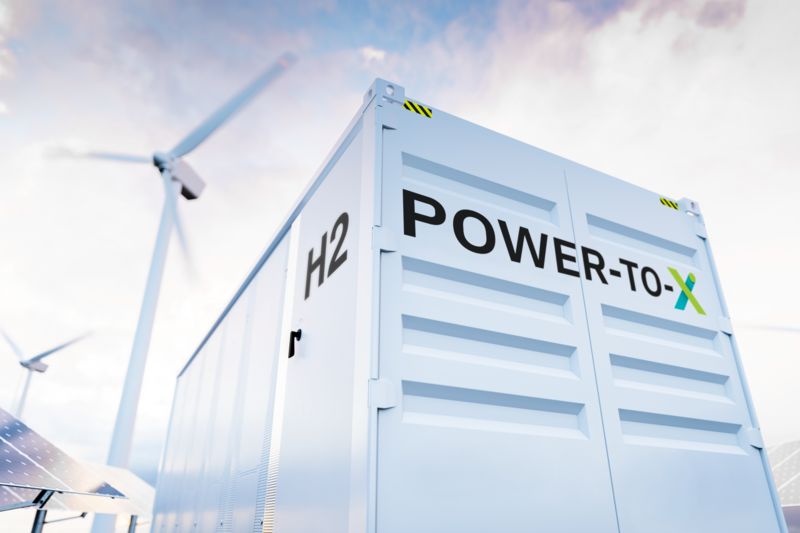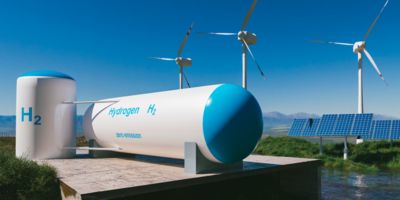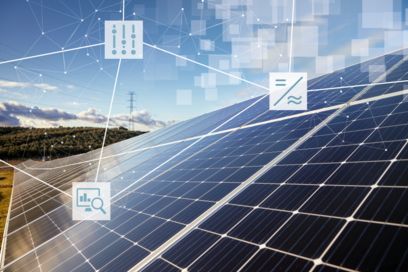What is green hydrogen? Green hydrogen is an energy carrier that is produced by the electrolysis of water, using only renewable energies.

Brief summary
In contrast to gray hydrogen, which is produced from fossil fuels, the production of green hydrogen does not result in any climate-damaging carbon emissions. Furthermore, it can be used as a storage medium for energy from renewable sources. Green hydrogen makes it possible to transport clean energy over large distances and use it in various sectors.

How is green hydrogen produced?
Green hydrogen is produced by electrolysis. In this process, water is broken down into its components, hydrogen and oxygen, using electrical energy. By using renewable energy sources, no greenhouse gases are emitted during the production process. In the electrolyzer, molecules of water (H₂O) are split into hydrogen (H₂) and oxygen (O₂) under the influence of electrical voltage.

Green hydrogen and power-to-X
Green hydrogen plays a central role in all power-to-X processes. By adding carbon (e.g., carbon dioxide, CO₂), climate-neutral e-methane can be produced by power-to-gas or e-fuels (synthetically produced liquid fuels) can be produced by power-to-liquid. Furthermore, it serves as a means of energy storage and as an energy carrier for power-to-heat. It can therefore be used for all three core technologies of power-to-X.
Storage of green hydrogen
There are various methods of storage, including storage in the form of compressed gas or as liquid hydrogen at extremely low temperatures to reduce the volume and improve transportability. Transporting hydrogen is challenging because safety and storage requirements must be met to minimize losses and hazards. Investment in the development and expansion of hydrogen storage infrastructure is essential in order to strengthen the role of green hydrogen as a reliable means of storing and supplying energy in a sustainable energy system.

Advantages and disadvantages
Green hydrogen is climate-friendly. It can be used in a wide range of applications, e.g., as a fuel, for power and heat generation, and as a raw material in industry. Surplus electricity from renewable sources can be converted into hydrogen and, when necessary, converted back into electricity. Furthermore, it can reduce dependence on fossil fuels.
The disadvantages include the high production costs and the energy-intensive process of electrolysis. In addition, the development of comprehensive infrastructure for the production, storage, and distribution of hydrogen requires significant investment. Lastly, hydrogen is highly flammable, which means that special safety measures are required for its storage and transportation.
Areas of application of green hydrogen
- Transport sector: reduced air pollution as a clean fuel for hydrogen cars, buses, and trucks
- Aviation and shipping: areas where electrical energy is difficult to use
- Industry, clean production: alternative raw material for promoting decarbonization in energy- and carbon-intensive processes
- Heating systems: replacement or supplement for existing natural gas networks (especially in cold regions where solar power is less efficient in winter due to low sunlight)
- Energy storage option: storage of surplus renewable energy from sunny and windy periods (promoting grid stability)
Summary
Green hydrogen plays a central role in the current debate about the energy transition, as it is seen as a key technology for the decarbonization of various sectors. Furthermore, the development and scaling of hydrogen technology promotes new economic opportunities and jobs by driving forward innovative technologies and infrastructures, which not only contributes to the energy transition, but also to economic transformation. As a result, green hydrogen is not only a step towards a sustainable energy future, but also an opportunity for far-reaching economic and ecological transformation.
Green hydrogen and the All Electric Society
The All Electric Society is a world in which energy from renewable resources is available in sufficient quantities and at affordable prices. A world in which renewable energy is generated and utilized consistently. In addition, the primary energy requirement is reduced through efficiency measures, and intelligent and networked systems are created. A central challenge of the All Electric Society lies in making electricity generated from renewable sources storable and transportable across sectors, thus enabling it to be used when needed. The production and use of green hydrogen is one way of achieving this.
Connect with our experts

More posts

What is power-to-gas?
Power-to-gas technology promotes the energy transition by contributing to grid stability and making renewable energy more efficient.

What is power-to-heat?
Power-to-Heat (PtH/P2H) describes a process in which excess electrical energy is converted into heat. This heat can be provided for direct use or fed into a heat storage system.

What is peak shaving?
How companies can benefit from peak shaving.



